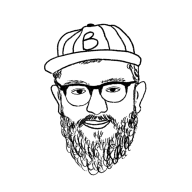On Patience, Grief

A view from the Avenues neighborhood of downtown Salt Lake City during a cold air pool on Dec. 2, 2010 Photo Credit, I Keep Running.
Last Wednesday, a whitish-grey mixture of clouds and smog covered the Salt Lake Valley, obfuscating the downtown skyscrapers and the mountains in the distance. Visibility was limited to a few stoplights.
Welcome to Beijing.
Inversion is the technical term for what was happening outside. In meteorology, an inversion is a deviation from the normal change of an atmospheric property (temperature) with altitude. The temperature itself is inverted. Clouds and smog are trapped in the valley by the cold air and the heat and clean air above and outside the valley, until a storm comes to restore balance. It could be a couple days. It could be a month.
My wife and I drove the eight miles or so to St. Mark’s Hospital, parked, walked up the stairs to the first floor, took the elevator to the fourth floor, signed in, and waited. Our normal doctor was off for the day, so we met with a midwife. My wife, Cat, was ten weeks pregnant but had been experiencing some worrisome symptoms. Signs of blood are never good. The midwife, a sweet lady in her mid-fifties with curly blonde hair, led us into the sterile room with two chairs, a small sink, and one of those bulky hospital bed-tables. She brought up Cat’s chart on the computer. She asked Cat questions. Cat responded, nervously. A large inhale.
The midwife said, “It could just be a UTI. But let’s do an ultrasound to make sure.”
We went to another, darker room. She looked inside. She could not find anything.
“The doctor said it was hiding two weeks ago,” Cat said as we sat there. Her on the table, me in a chair, the midwife’s eyes locked onto the computer screen … “but we still were able to find the heartbeat.”
“Hmm. I’m not finding anything, but let me grab the doctor.”
We sat there in the shadowy room. A single, solitary lamp and computer screen lit the darkness.
After a solid fifteen minutes, the doctor, a short, Japanese man with a friendly demeanor came by.
He also looked.
On the screen there was a circle in black and white inside a trapezoid with equal sides.
“Yes, well, as I’m sure you know, here,” the doctor pointed on the screen, “is where we’re looking at the uterus. Think of this as the condo for your baby,” he said. “But you can start to see here,” he pointed to the southwest corner of the picture,” that it’s not a perfect circle. It’s collapsing.”
It looked like a balloon deflating.
But he didn’t stop there.
“And for a baby of ten weeks, we’d expect to see something in the condo.”
There was nothing in the condo.

* * *
I’ve never been a patient person. In middle school, I wanted to be in high school; in high school, I wanted to be in college; in college, I wanted to be working in the real world. Then, when I was working in the real world, I wanted to be back in college.
And: When I was single, I wanted to be engaged; when I was engaged, I wanted to be married; when I was married, I wanted to have kids because if we were eventually going to have kids, well, we might as well start and not put it off.
Likewise: When I started writing, I immediately wanted to get published. Then, I wanted to be a full-time writer already. And I couldn’t understand why it was all taking so long. I didn’t even want to be a bestselling author—I just wanted to be tapped into the vein of the literary bloodstream.
Patience, endurance, and self-control are virtues I very much lack.
Because I am a young man, my writing is still, primarily, about me. I hope to change in the years to come, to exist outside of myself and for issues outside of my world, but for now it’s difficult for me to write about anything that is not deeply personal. I write to process, at least in initial, first-draft-sort-of-writing. I cannot write about anything other than what I am processing. Generally, it is existential—the search for meaning. Sometimes, it is the existence of God, or police brutality, or racism, or systemic inequality, but generally it is what is happening right now, in front me.
When I sat down to write this blog post, there was only one thing continually running through my mind. Grief. Not teary-eyed-spasms-of-emotion. Just blank, listless, merciless, monotonous grief.
This is the form grief takes for me. It may be different for others.
* * *
“The word we use for this is miscarriage.” The doctor said, spelling it out for us in full, in case we were confused by his earlier analogies.
The technical term is miscarriage, a deviation from the normal change expected in a woman’s body. The fetus itself is inverted, and by inverted I mean no more.
Ten to twenty percent of pregnancies end in miscarriage.
Before this pregnancy, words relating to the female anatomy used to make my head warm and slippery. Words like uterus, ovulation, Fallopian tube, spotting, heavy bleeding. I didn’t want to hear any of it. I was still getting used to being married. But now I heard all of it in rapid succession.
Real life shit. No more romantic comedy shit. No more movie-magazine shit. Real life shit.
My wife cried on the white paper tissue wrapped atop the bulky table.
The doctors left us. We embraced. And then we left the hospital and both went back to work because we had to. I listened to David Bowie’s Blackstar and tried not to cry.
I felt strange the rest of the day, largely because I had just spent ten weeks acclimating myself to the idea of fatherhood, and I hadn’t actually become excited about the baby until a week earlier. It all felt too otherworldly and surreal. I had finally made peace with the idea, and excitement had begun to creep in.
But then, Wednesday.
Wednesday felt symbolic: Don’t get your hopes up. Expect the worse. Everything is polluted.
Welcome to Beijing.
No more.
* * *
Thursday, we both took a half-day. I was in the next room when I heard a cry of pain from Cat in the bathroom. This was it. She felt a plop, she said, so much blood.
The next day some of Cat’s girlfriends came over. The day after, some friends brought us dinner. We made the appropriate calls.
I did not want to talk to anyone about anything.
Sunday, I woke up hung-over, and we took our dog to the dog park and then ate lunch and came home and watched TV separately in different rooms of the house. I watched The Wire, and she watched True Blood, because apparently we were both behind on HBO shows from the early 2000s.
My wife and I are both devastated, but I know I will never understand the violence and trauma a miscarriage commits against a woman’s body. I never will. And so I do my best to be there for her. In whatever little way I can. With the tissue and the blood.
I came home Monday to the trash dragged over the kitchen floor by our dog. I yelled at her, cleaned it up, and lay down on the couch. I pulled the blanket over my eyes to blot out the ceiling light. There were not enough blankets.
I’ve never been good with patience. I’ve never been good with grief.
Why the hell does it all take so long?
Perhaps I am still too young to have perspective on the wide arc of history, especially my own. I think about what an older friend once said to me: “Life crumples up, but it eventually straightens out again, and I try not to worry about the in-between too much anymore.” I’ve adopted this as a sort of guidepost because it’s honest but not completely despairing.
Our culture doesn’t like to talk about suffering or death. It goes against the core of American ideals: youth, beauty, prosperity, and happiness. And I think because of this, we young people, who are generally privileged because we are isolated from death and suffering, are caught off guard when they come knocking. How to deal with grief or practice patience are not priorities we, as a society, hold very closely. We want everything instant and airbrushed. I think art, therefore, should disrupt this.
If it were up to me now, I’d end up in total despair about the state of the world, the state of my world, the state of my household’s grief. My friend’s wisdom is a perspective I hope one day to fully understand. And perhaps one day I will. With time.

Levi Rogers is a writer and coffee roaster out of Salt Lake City, UT. He lives with his wife Cat, his dog Amelie, and his many socks, all of which have holes. He’s currently an MFA candidate at Antioch University Los Angeles.





